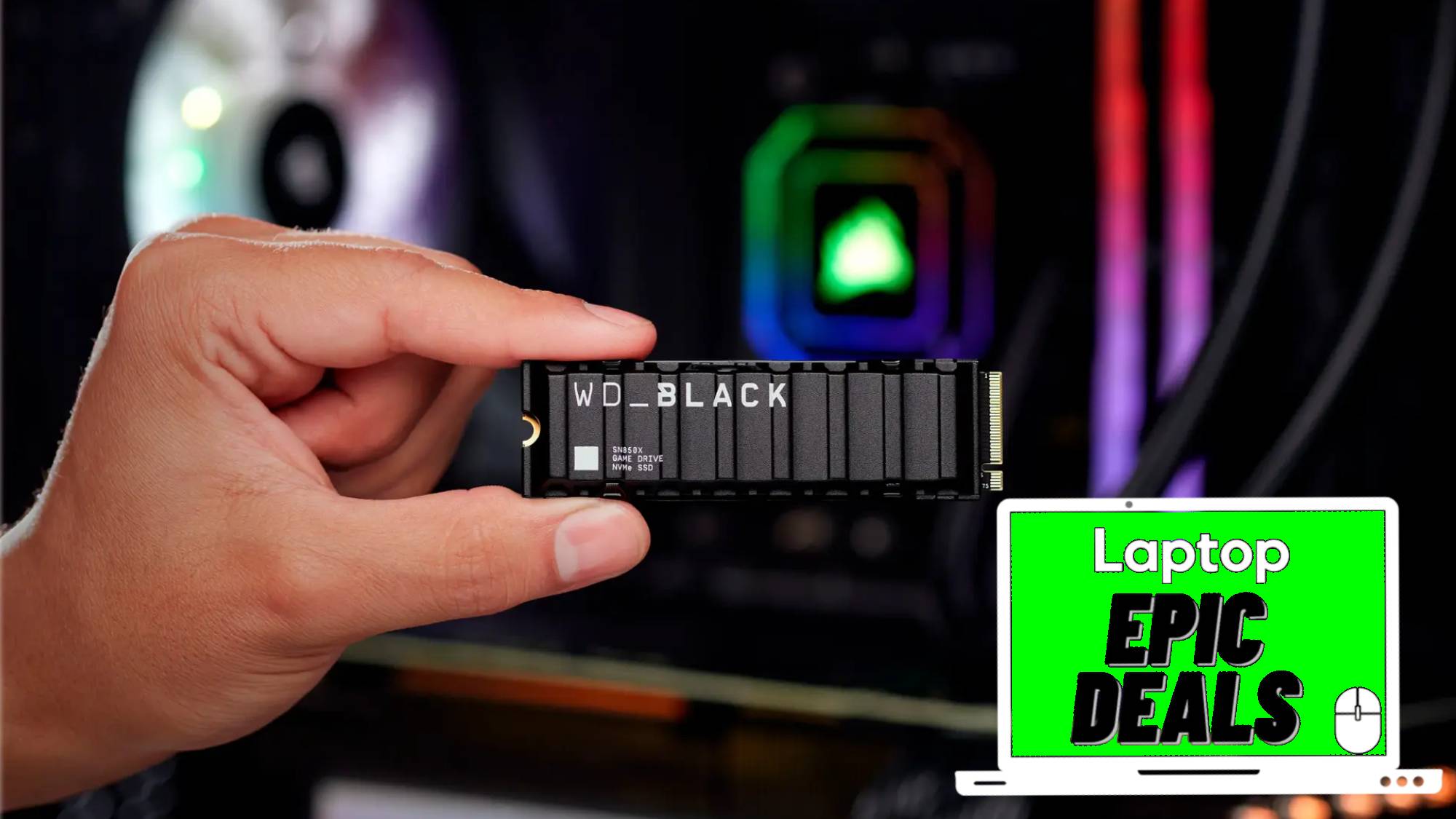Laptop Mag Verdict
As if a full HD screen, Blu-ray, and Core i7 processing power weren't enough, Sony includes its new TransferJet technology in this multimedia laptop.
Pros
- +
Fast Core i7 processor
- +
Comfortable backlit keyboard
- +
Full HD display and Blu-ray drive
Cons
- -
Relatively weak speakers
- -
TransferJet technology is slow, expensive
Why you can trust Laptop Mag
When it comes to big-screen notebooks packing Intel's blazing Core i7 processor, Sony is definitely playing catch-up with the rest of the field. But the VAIO F Series ($1,719) proves that there's nothing wrong with being late to the party: this 16.4-incher sports a full HD display, Blu-ray player, and discrete graphics. Sony also includes an innovative technology called TransferJet, which allows users to move photos from select cameras by merely placing them on the laptop's palm rest (albeit with added cost and time). This multimedia machine has some drawbacks, but when it comes to performance, the F Series is one of the best Core i7 notebooks around.
Design
Although the VAIO F has clean lines, the overall look almost feels too safe. The notebook has an understated matte lid embossed with the VAIO logo, and a matching chassis underneath, complete with a subtly textured palm rest. In the lower left corner of the palm rest is an icon indicating where users can transfer data wirelessly using TransferJet (more on this later).
The keyboard, of course, has an island-style layout, something Sony was known for long before other PC makers jumped on board and started ditching those pillowy, closely arranged keys. Below the thick speaker strip (but above the keyboard) you'll find multimedia keys, as well as buttons to launch Sony's VAIO Care and Media Gallery software. The glowing green power button is still built into the side of the hinge, which is an attractive touch.
At 6.6 pounds and 15.3 x 10.4 x 1.6 inches, the VAIO F is still light enough to carry around the house with ease.
Heat
For the most part, the VAIO F Series never became uncomfortably hot. After 15 minutes of streaming a Hulu video at full screen, we measured temperatures of 86 degrees Fahrenheit on the underside of the notebook, 97 degrees in the center of the keyboard, and 98 degrees on the touchpad. (While temperatures in the 90s are warm, we don't become concerned until they break 100 degrees.) On the bottom of the notebook--near the vents on the left side--we measured temps of 110 degrees.
Keyboard and Trackpad
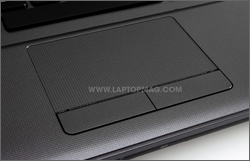
Click to enlarge
We quickly took to the VAIO F's island keyboard, which combines a sturdy panel with large keys whose satin finish feels soft to the touch. We'd even go so far as to say that the keyboard is as comfortable as the famed keyboards on Apple's MacBooks and MacBook Pros. The backlighting, which turns on automatically in dim settings, is also a cool perk.
The VAIO F has a full number pad--a plus for gamers--so you'll have to get used to typing left of center on the keyboard deck. Even typing at what felt like a slow, ginger pace, we were still able to notch 88 words per minute on the Ten Thumbs Typing Tutor, which is also our high score on the office desktop we use every day.
Sony got the touchpad-and-buttons combo right. The pad, which measures a comfy 2.0 x 3.3 inches, has low friction and bears the same subtle checked pattern as the palm rest, although its texture is smooth, not bumpy.
The trackpad also supports multitouch gestures, such as pinching and zooming. Getting the hang of these motions took a few tries, partly because the touchpad isn't quite large enough to comfortably use two fingers at once. Also, we found that for gestures such as zooming, we had to apply a certain amount of pressure on the pad, and move our fingers at a certain speed. It wasn't difficult to learn, and the pictures on screen resized themselves smoothly; just know there's a small learning curve.
As for the mouse buttons, they're easy to press without feeling too stiff or mushy. And they're large enough to comfortably rest a finger there.
Display and Audio
The VAIO F's 1920 x 1080 display delivers with a 16.4-inch panel that's perfect for watching movies (Sony pairs it with a Blu-ray player). When we watched Iron Man on Blu-ray, details such as the flames in explosions looked crisp. On the other hand, the display didn't look as bright as others we've tested recently, such as the Acer Aspire 8940G or Dell Studio 17. The viewing angles from the side were good despite the glossy finish, which means various people can sit around this big-screen laptop and watch a movie together.
The speakers, located above the keyboard, produced surprisingly tinny sound; when we streamed various Motown songs from Slacker, the bass notes were pretty weak. And when we watched our Iron Man Blue-ray, the notebook achieved neither the volume nor richness in tone that we enjoyed when we viewed the same movie on the Aspire 8940G. To be fair, that's a 18.4-inch system with enough room for five speakers and a bass booster.
Ports and Webcam
The port list on the VAIO F is what you'd expect in a large multimedia notebook: two USB 2.0 ports, HDMI and VGA outputs, a S/PDIF port, an Ethernet jack, headphone and mic ports, separate slots for SD and Memory Stick Cards (we think a multiformat slot would be better), and an ExpressCard/34 slot.

Click to enlarge

Click to enlarge
The 1.3-megapixel webcam makes still photos and videos look brighter and more colorful than most. However, because of the relatively low resolution, our images weren't the most detailed. On the bright side, the included ArcSoft WebCam Companion 3's sleek black UI is more refined than previous versions of the software. A feature called Masques, which make it easy to blend your face with, say, an elf's, produces funny results, and is effortless to use.
Like other vendors, such as HP, Sony includes face tracking technology with its webcam, which means the camera will pan and zoom to follow your face, keeping it in focus, as you move around in front of the camera.
TransferJet
The most unique thing about the VAIO F Series is that it's part of a flagship generation of Sony products to include TransferJet, a proprietary technology that allows users to wirelessly transfer data--such as photos--from one enabled device to another.
Right now, the technology is being embedded into select Sony notebooks and cameras, so one could take advantage of TransferJet by either touching two such digital cameras together or, as in this case of the VAIO F Series, placing a TransferJet camera on top of a similarly equipped VAIO laptop. Sony allows users to transfer up to 20 photos at once, and promises speeds of up to 560 Mbps, which is supposedly faster than wireless-G, wireless-N, and wireless USB.
Although TransferJet-enabled notebooks, such as this one, simply have the technology built in, Sony Cybershot camera owners have to go one step further: in addition to purchasing an eligible camera, they have to use a special TransferJet Memory Stick (a $50 premium), as opposed to a regular Memory Stick or an SD Card.
To use TransferJet, you'll have to turn your camera on and place it into playback mode before setting it on the VAIO F's TransferJet pad, located on the palm rest. Almost immediately, we saw a message in our system tray indicating that our VAIO had recognized our TransferJet-enabled camera. The trick to getting TransferJet to work is aligning the part of the camera that houses the memory card with the TransferJet icon on the VAIO. Once we did this, the computer took just three seconds to spit back a dialog box, asking us to click Import to approve the transfer. Copying nine 10.2-megapixel photos took just 7 seconds. Transferring these photos plus a one-minute AVCHD movie taken with the same camera took 25 seconds. Then, Picture Motion Browser, Sony's photo viewing software, launched without a blip, and we could immediately see our photos in the library.
Although this process is neat and easy to master, it's neither the fastest nor the least expensive option. All Sony cameras now support both Memory Stick as well as SD, the cheaper and more popular of the two formats. An 8GB SD Card won't work with TransferJet, but it's hard to argue with the $40 price tag (remember that the premium alone for a TransferJet Memory Stick is $50, meaning it costs $50 more than a Memory Stick with the same capacity).
Secondly, transferring via USB is still faster. Whereas copying those nine photos and that one-minute video clip took 25 seconds with TransferJet, it took just 9 seconds using the camera's included USB cable.
Performance
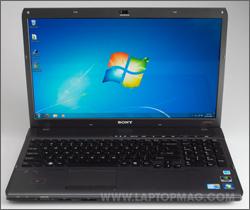
Click to enlarge
Our configuration of the VAIO F featured a 1.60-GHz Intel Core i7-720QM processor (which overclocks to 2.8-GHz), 8GB of RAM, Windows 7 Home Premium (64-bit), and a 500GB hard drive running at a fast 7,200 rpm. On PCMark Vantage, a benchmark measuring general performance on Windows machines, the VAIO F scored 6,880, which steamrolls the desktop replacement category average of 4,498. The VAIO F's strong showing isn't surprising: the benefit of Core i7 processors is that their quad-core architecture offers blazing performance. However, this VAIO beat both the Core i7-powered Dell Studio 17 (5,201) and Acer Aspire 8940G (5,962).
The 7,200-rpm hard drive is fast, too; it copied a 4.97GB folder of mixed media at a rate of 29.2 MBps, which beats the category average of 27.5 MBps. The 50-second boot time far exceeds the 66-second category average.
In our hands-on testing, everyday computing, such as launching our browser and switching between tabs for our Twitter feed, NYTimes.com, a favorite blog, Hulu, and Slacker, was seamless. The only time the computer choked was when we had just inserted a Blu-ray movie to play using Corel WinDVD BD Reference Player, and briefly switched back to our browser to take one last look at one of our tabs. When we closed the browser, we enjoyed smoother performance from WinDVD.
Video Conversion
The quad-core Core i7 platform really shines when it comes to heavy duty multimedia tasks. For instance, when we transcoded a five-minute-and-five-second MPEG-4 video clip to AVI using HandBrake, it took just 2:49, whereas the average desktop replacement takes 4:49. What's more, when we used Oxelon Media Converter, which takes advantage of the notebook's multiple cores, that time dropped to an incredible 53 seconds. Both of these scores are even faster than what the also-speedy Core i7-powered Aspire 8940G and Studio 17 delivered.
Graphics
Armed with discrete Nvidia GeForce GT 330M graphics and a full gigabyte of video memory, the VAIO F delivers strong performance, even if it doesn't match a dedicated gaming rig when it comes to frame rates. Its 3DMark06 score of 6,577 falls nearly 570 points below the category average. However, it scored better than the $1,164 Dell Studio 17 with Core i7 (6,494).
When we played various games, including World of Warcraft and Far Cry 2, we enjoyed high frame rates only when we lowered the resolution; at the machine's native resolution (1920 x 1080) they were fairly slow, but still playable. For example, World of Warcraft ran at 60 frames per second at 1024 x 768 resolution and 39 fps at full HD. Likewise, Far Cry 2 ran at 81 fps at 1024 x 768 and slowed to just 20 fps at its native resolution and effects increased to Very High. That's about what we saw with the Core i7-enabled Studio 17 (82 fps and 29 fps in Far Cry 2), but still not as high as the Envy 15's Far Cry 2 frame rates (95 fps and 27 fps).
Battery Life and Wi-Fi
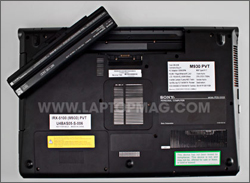
Click to enlarge
The VAIO F Series' battery lasted 2 hours and 25 minutes when Web surfing over Wi-Fi, which is just five minutes shy of the desktop replacement category average (2:30). Given that this 16.4-inch machine isn't intended to be left unplugged for very long, this shouldn't be a deal-breaker.
As for the Atheros 802.11b/g/n radio, it managed throughput of 19.6 Mbps and 17.8 Mbps at 15 and 50 feet, respectively. That's on a par with other desktop replacements at 15 feet, yet slightly slower at 50 feet. Indeed, sitting across our office from our wireless-N router, we still saw all five bars of Wi-Fi connectivity, and had no problem streaming a full-screen HD Hulu clip smoothly. The VAIO F also has Bluetooth 2.1 + EDR.
Energy Efficiency
The VAIO F took 2 hours and 39 minutes to charge 80 percent, and 3:29 to fully recharge. During this time, it consumed a total of 11348.7 watts. To put that in perspective, the average desktop replacement eats up 9209.1 watts while charging. The LAPTOP Battery Efficiency Rating (battery life divided by the total watts consumed during charging) of 78.3 isn't too impressive next to the category average of 79.0.
Software and Warranty
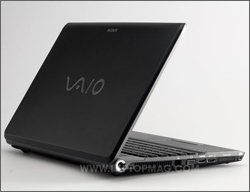
Click to enlarge
Defying its reputation for loading laptops with a generous helping of bloatware, the F Series comes with a fairly standard amount of software. It comes with Google Toolbar for Internet Explorer, QuickBooks Financial Center, Microsoft Works SE 9.0, trials of Microsoft Office Home and Student 2007 and Norton Internet Security 2010, and full versions of Corel WinDVD BD Reference Player and Roxio Easy Media Creator 10. We could do without most of those, but WinDVD and Media Creator 10 are useful apps for a multimedia machine.
Sony also includes a selection of its own proprietary multimedia and utility software. First, there's Sony's VAIO Media Gallery, which users can launch by pressing a dedicated button on the keyboard. Users can import photos and videos, and then add themes and soundtracks to create movies and slideshows. Much like the FlipShare software that comes with Flip digital cameras, it's designed to automate the movie-making process. Then there's VAIO Care, which users can also access using a launch button on the keyboard. This maintenance tool combines tune-up features normally packaged inside premium security suites, as well as troubleshooting tips.
The VAIO F Series comes with a one-year limited warranty, including one year of 24/7 toll-free phone support. To learn how Sony did in our annual Tech Support Showdown, click here.
Verdict
With the VAIO F, Sony packs a lot into a very good multimedia notebook. You'll get a full HD 16.4-inch display, an Intel Core i7 processor, discrete Nvidia graphics, and Blu-ray playback. At $1,719, the price seems steep, but it's not much more expensive than competing machines. For example, the HP Pavilion dv6 costs $100 less when similarly configured, and it lacks a 1080p display. Although this system's TransferJet functionality isn't much more than a novelty at this point, and the gaming performance isn't the strongest, the VAIO F is a compelling multimedia laptop.
Sony VAIO F Series Specs
| Bluetooth | Bluetooth 2.1 EDR |
| Brand | Sony |
| CPU | 1.60-GHz Intel Core i7-720QM |
| Card Slots | ExpressCard/34, SD memory reader, microSD |
| Company Website | http://www.sony.com |
| Display Size | 16.4 |
| Graphics Card | Nvidia GeForce GT 330M |
| Hard Drive Size | 500GB |
| Hard Drive Speed | 7,200rpm |
| Hard Drive Type | SATA Hard Drive |
| Native Resolution | 1920x1080 |
| Operating System | MS Windows 7 Home Premium (64-bit) |
| Optical Drive | BD-R |
| Ports (excluding USB) | HDMI, Ethernet, VGA, S/PDIF, Microphone, Headphone |
| RAM | 8GB |
| RAM Upgradable to | 8GB |
| Size | 15.3 x 10.4 x 1.6 inches |
| USB Ports | 2 |
| Video Memory | 1GB |
| Warranty/Support | One-year/One-year 24/7 toll-free phone |
| Weight | 6.6 pounds |
| Wi-Fi | 802.11b/g/n |
